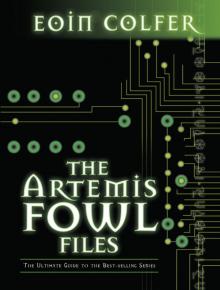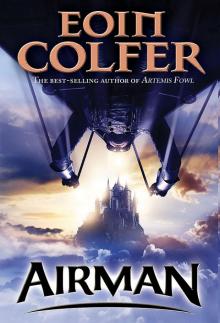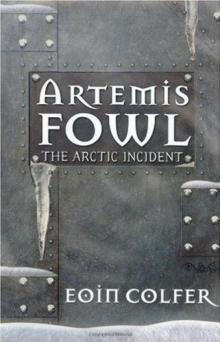- Home
- Eoin Colfer
The Time Paradox Page 3
The Time Paradox Read online
Page 3
“Remember, Holly, this is just reconnaissance. Go down and check the sensor. Those things are two hundred years old, and the problem is more than likely a simple overheat. All you need to do is go where I tell you and fix what I tell you. No indiscriminate blasting involved. Understand?”
Holly snorted. “I can see why Caballine fell for you, Foaly. You’re such a charmer.”
Foaly snickered. “I don’t rise to jibes anymore, Holly. Marriage has mellowed me.”
“Mellowed? I’ll believe that when you last ten minutes in a room with Mulch without throwing a hoof.”
The dwarf Mulch Diggums had been at various times enemy, partner, and friend to Holly and Foaly. His greatest pleasure in life was stuffing his face, and not far behind that was irritating his various enemies, partners, and friends.
“Perhaps I need a few more years of marriage before I get that mellow. A few more centuries, in fact.”
The island was large in Holly’s visor now, surrounded by a monk’s fringe of foam. Time to stop the chitchat and proceed with the mission, though Holly was tempted to circle in a holding pattern so she could talk some more with her friend. It seemed as though this was the first real conversation they’d had since her return from Limbo. Foaly had moved on with life in the past three years, but for Holly her absence had lasted only a few hours, and, though she had not aged, Holly felt cheated of those years. The LEP psychiatrist would have told her she was suffering from Post-time-travel-displacement Depression, and offered to prescribe a nice shot to cheer her up. Holly trusted happy-shots just about as much as she trusted brain implants.
“I’m going in,” she said tersely. This was her first solo mission since debriefing, and she did not want anything less than a perfect report, even if it was only Kraken Watch.
“Copy,” said Foaly. “You see the sensor?”
There were four bio-sensors on the island relaying information back to Police Plaza. Three pulsed a gentle green in Holly’s visor display unit. The fourth sensor was red. Red could mean many things. In this case, every reading had risen above normal levels. Temperature, heartbeat, brain activity. All on the danger line.
It must be a malfunction, Foaly had explained. If not, the other sensors would show something.
“I have it. Strong signal.”
“Okay. Shield and approach.”
Holly twisted her chin sharply left until her neck bone clicked, which was her way of summoning the magic. It wasn’t a necessary movement, since the magic was mostly a brain function, but fairies developed their own tics. She let a dribble of power into her limbs and vibrated out of the visible spectrum. Her Shimmer Suit picked up her frequency and amplified it so that a tiny spark of magic went a long way.
“I’m out of sight and going in,” she confirmed.
“Understood,” said the centaur. “Be careful, Holly. Commander Kelp will be reviewing this video, so stick to your orders.”
“Are you suggesting that I occasionally stray from the rule book?” said Holly, apparently horrified by the very notion.
Foaly sniggered. “I am suggesting that you may not own a copy of the rule book, and if you do possess one, you certainly have never opened it.”
Fair point, thought Holly, swooping down toward the surface of Uunisaari.
Whales are thought to be the world’s largest creatures. They are not. The kraken can stretch to three miles in length and have been a staple of Scandinavian legend since the thirteenth century, when they appeared in the Orvar-Odd saga as the fearsome lyngbakr. Early descriptions of the kraken are the most accurate, describing the sea creature as an animal the size of a floating island whose real danger to ships was not the creature itself, but the whirlpool it created when it sank into the ocean. But by the Middle Ages the legend of the kraken had been confused with that of the giant squid, and each credited with the most fearsome attributes of the other. The squid was pictured as big as a mountain, while the peaceful kraken grew tentacles and developed a bloodlust to rival that of the deadliest shark.
Nothing could be further from the truth. The kraken is a docile creature whose main defenses are its sheer size and the bulk of shell, gas, and fat cells enclosing a melon-size brain, which provides it with just enough intelligence to feed itself and shed its shell. Underneath the crust of rock, weed, and coral, the kraken resembles nothing more than the common acorn barnacle, albeit a barnacle that could easily house an Olympic stadium or two.
Kraken enjoy a lifespan of several thousand years, thanks to an incredibly slow metabolism and a huge network of support systems surrounding their soft centers. They tend to settle in a food-rich or magical environment and remain there until the food or energy residue runs out. Nestling in the middle of an archipelago near a human port provides not only camouflage but an abundant source of edible material. And so this is where kraken are found, anchored to the seabed like gigantic limpets, vacuuming city waste through their gills and fermenting it into methane in their vast stomachs. But if human garbage is their salvation, it is also their damnation, for increasingly high toxin levels have rendered the kraken sterile, and now there are less than half a dozen of the ancient creatures left in the oceans.
This particular kraken was the oldest of the bunch. According to shell scrapings, old Shelly, as the small dedicated Kraken Watch referred to it, was more than ten thousand years old, and had been masquerading as an island in Helsinki Harbor since the sixteenth century, when the town was known as Helsingfors.
In all that time, Shelly had done little but feed and sleep, feeling no urge to migrate. Any need he may have felt to move on was dulled by the seepings of a paint factory built on his back more than a hundred years previous. For all intents and purposes, Shelly was catatonic, having emitted no more than a couple of methane flashes in over fifty years, so there was no reason to believe that this red light on his sensor was anything more than a crossed wire, and it was Holly’s job to uncross it. It was a standard first-day-back-on-the-job kind of mission. No danger, no deadline, and little chance of discovery.
Holly turned her palms into the wind, descending till her boots scraped the roof of the island’s small restaurant. Actually there were two islands, separated by a small bridge. One was a genuine island, and the other larger section was old Shelly nestled into the rock. Holly ran a quick thermal sweep, finding nothing but a few rodents and a blotch of heat from the sauna, which was probably on a timer.
Holly consulted her visor for the sensor’s exact location. It was twelve feet underwater, tucked below a rocky ledge.
Underwater. Of course.
She stowed her wings, midair, then plunged feetfirst into the Baltic Sea, corkscrewing to minimize the splash. Not that there were any humans close enough to hear. The sauna and restaurant did not open until eight, and the nearest fishermen were on the mainland, their rods swaying gently like rows of bare flagpoles.
Holly vented the gas bags in her helmet to reduce buoyancy, and sank below the waves. Her visor informed her that the water temperature was a little over ten degrees, but the Shimmer Suit insulated her from cold shock and even flexed to compensate for the slight pressure increase.
“Use the Critters,” said Foaly, his voice crystal clear through the vibration nodes over her ears.
“Get out of my head, centaur.”
“Go on. Use the Critters.”
“I don’t need a tracer. It’s right there.”
Foaly sighed. “Then they shall die unfulfilled.”
The Coded Radiation Tracers were microorganisms bathed in radiation of the same frequency as the object being located. If you knew what you were looking for before leaving Foaly’s workshop, then the Critters would bring you right to it; though they were a little redundant when the sensor was a few feet away and beeping on your screen.
“Okay,” moaned Holly. “I wish you would stop using me as a guinea pig.”
She pulled back a watertight flap on her glove, releasing a cloud of glowing orange mites into the water. They
bunched for a moment, then sped off in a ragged arrow toward the sensor.
“They swim, they fly, they burrow,” said Foaly, awed by his own achievement. “God bless their tiny hearts.”
The Critters left a glowing orange wake for Holly to follow. She pulled herself below a sharp ledge, to find the Critters already excavating the growths covering the sensor.
“Now, come on. That is handy. Tell me that’s not useful to a field officer.”
It was very useful, especially since Holly only had ten minutes of air left; but Foaly’s head was big enough as it was.
“A gill helmet would have been more useful, especially since you knew the sensor was underwater.”
“You have more than enough air,” argued Foaly. “Especially since the Critters are clearing the surrounding area.”
The Critters ate away the rock and moss covering the sensor until it gleamed like the day it came off the assembly line. Once their mission was completed, the Critters flickered and died, dissolving in the water with a gentle fizz. Holly switched on her helmet lights and focused both beams on the alloy instrument. The sensor was the size and shape of a banana and covered with an electrolytic gel.
“The water is pretty clean, thanks to Shelly. I’m getting a decent picture.”
Holly topped up her suit buoyancy a few notches until she was at neutral, and hung in the water as still as she could.
“Well, what do you see, Foaly?”
“The same as you,” replied the centaur. “A sensor with a flashing red light. I need to take a few readings, if you wouldn’t mind touching the screen.”
Holly laid her palm on the gel so that the omnisensor on her glove could sync with the ancient instrument.
“Nine and a half minutes, Foaly, don’t forget.”
“Please,” snickered the centaur, “I could recalibrate a fleet of satellites in nine and a half minutes.”
It was probably true, thought Holly, as her helmet ran a systems check on the sensor.
“Hmm,” sighed Foaly, thirty seconds later.
“Hmm?” repeated Holly nervously. “Don’t hmm, Foaly. Dazzle me with science, but don’t hmm.”
“There doesn’t seem to be anything wrong with this sensor. It is remarkably functional. Which means . . .”
“That the other three sensors are malfunctioning,” concluded Holly. “So much for your genius.”
“I did not design these sensors,” said Foaly, wounded. “They’re old Koboi gear.”
Holly shuddered, her body jerking in the water. Her old enemy Opal Koboi had been one of the People’s leading innovators, until she decided that she would prefer to pursue all criminal avenues to crown herself queen of the world instead. Now she was housed in a specially constructed isolation prison cube suspended in Atlantis, and spent her time shooting off mail to politicians, pleading for early release.
“Apologies, old friend, for doubting your wonderfulness. I suppose I should check the other sensors. Above sea level, I do hope.”
“Hmm,” said Foaly again.
“Please stop that. Surely, now that I am here, I should check the remaining sensors?”
Silence for a moment as Foaly accessed a few files, then he spoke in hitched phrases while the information opened before him. “The other sensors . . . are not the pressing issue . . . right now. What we really need to know . . . is why would Shelly be redlining on this sensor. Let me just see . . . if we have ever had these kind of readings before.”
Holly had no choice but to maintain contact with the sensor, legs swaying underneath her, watching the air clock on her visor run down.
“Okay,” said Foaly finally. “Two reasons for a kraken’s readings to redline. One, Shelly is having a baby kraken, which is impossible since he’s a sterile male.”
“That leaves two,” said Holly, who was certain that she would not like the second reason.
“And two. He’s shedding.”
Holly rolled her eyes in relief. “Shedding. That doesn’t sound so bad.”
“Weeeellll, it’s a little worse than it sounds.”
“What do you mean, a little?”
“Why don’t I explain as you fly away as fast as you can.”
Holly did not need to be told twice. When Foaly advised an officer to leave before he delivered one of his beloved lectures, then the situation was serious. She spread her arms wide, and the action was mimicked by the wings on her back.
“Engage,” she said, pointing both arms to the surface; the engines ignited and blasted her clear of the Baltic, boiling the water wake as it hung in the air. Her suit was instantly dry as moisture slipped from its nonstick material and air resistance tugged at any remaining drops. In seconds she had climbed to a few hundred feet, the anxiety in Foaly’s voice hurrying her along.
“A kraken sheds its shell once, and records show that Shelly dumped his three thousand years ago, so we presumed that was that.”
“But now?”
“Now it seems as though Shelly has lived long enough to do it again.”
“And why are we concerned about this?”
“We are concerned about this because kraken shed very explosively. The new shell has already grown, and Shelly will get rid of the old one by igniting a layer of methane cells and blasting it off.”
Holly wanted to be sure she understood what was being said. “So you’re saying that Shelly is going to light a fart?”
“No, Shelly is going to light the fart. He has stored enough methane to power Haven for a year. There hasn’t been a fart like this since the last dwarf tribal gathering.”
A computer representation of the explosion appeared in Holly’s visor. To most fairies the image would be little more than a blur, but LEP officers were forced to develop the double focus necessary to read their screens and watch where they were going at the same time.
When the simulation put Holly clear of the projected blast radius, she dropped her boots, swinging in a loose ascending arc to face the kraken.
“Isn’t there something we can do?”
“Besides take a couple of pictures? Nope. Too late for that. Only a few minutes to go. Shelly’s inner shell is already at ignition temperature, so put your glare filter down and watch the show.”
Holly lowered her shade. “This is going to make the news all over the world. Islands don’t just explode.”
“Yes they do. Volcanic activity, gas leaks, chemical accidents. Believe me, if there’s one thing the Mud Men do know, it’s how to explain away an explosion. The Americans invented Area 51 just because a senator crashed a jet into a mountain.”
“The mainland is safe?”
“Should be. A little shrapnel, maybe.”
Holly relaxed, hanging from her wings. There was nothing she could do, nothing she should do. This was a natural process, and the kraken had every right to shed its shell.
Methane explosions. Mulch would love this.
Mulch Diggums was currently running a private investigations office in Haven with the pixie wheel-fairy Doodah Day. Mulch had, in his day, caused some methane disturbances himself.
Something pulsed gently in Holly’s visor. A plasma splotch of red in the thermal sweep windows. There was life on the island, and not just insect or rodent. Multiple humans.
“Foaly. I have something.”
Holly resized the window with a series of blink commands to track down the source. There were four hot bodies inside the sauna.
“Inside the sauna, Foaly. How did we miss them?”
“Their bodies were at the same temperature as the brick walls,” replied the centaur. “I’m guessing that one of the Mud Men opened the door.”
Holly magnified her visor to plus four and saw that the sauna door was open a crack, a wedge of steam pushing through the gap. The building was cooling faster than the humans, and so now they showed up separately on her scanner.
“What are those Mud Men doing here? You said nothing opens until eight.”
“I don’t know, Ho
lly. How would I know? They’re humans. About as reliable as moon-mad demons.”
It didn’t matter why the humans were there, and wondering about it was a waste of time.
“I have to go back, Foaly.”
Foaly put a camera on himself, broadcasting his live image to Holly’s helmet.
“Look at my face, Holly. Do you see this expression? This is my stern face. Do not do it, Holly. Do not return to the island. Humans die every day, and we do not interfere. The LEP never interferes.”
“I know the rules,” said Holly, muting the growling centaur.
There goes my career again, she thought, angling her wings for a steep dive.
Four men sat in the sauna’s outer room, feeling very smug that they had once again outwitted island authorities and managed to sneak a free sauna before work. It did help that one of the men was Uunisaari’s security guard and had access to the keys, and a little five horsepower punt that accommodated the four friends, and a bucket of Karjala beer.
“Good temperature in the sauna today,” said one.
A second wiped the steam from his glasses. “A little hot, I thought. In fact, even here it feels hot underfoot.”
“Go jump in the Baltic, then,” said the guard, miffed at this lack of appreciation for his efforts. “That will cool down your poor toesies.”
“Don’t pay any attention to him,” said the fourth man, fastening his watch. “He has sensitive feet. Always some temperature problem.”
The men, friends since childhood, laughed and swigged their beers. The laughing and swigging ceased abruptly when a section of the roof suddenly caught fire and disintegrated.
The guard coughed out a mouthful of beer. “Was someone smoking? I said no smoking!”
Even if one of his sauna buddies had answered, the guard would not have heard, as he had somehow managed to fly through the hole in the roof.
“My toes are really hot,” said the bespectacled man as if hanging on to old topics of conversation could make new ones go away.
The others ignored him, busy doing what men generally do in dangerous times: putting on their trousers.
There was no time for introductions or doors, so Holly drew her Neutrino sidearm and carved a six-foot hole in the roof. She was treated to the sight of four pale, semi-dressed Mud Men quivering in sudden fright.

 Artemis Fowl
Artemis Fowl Plugged
Plugged The Opal Deception
The Opal Deception The Arctic Incident
The Arctic Incident The Wish List
The Wish List Novel - Half Moon Investigations
Novel - Half Moon Investigations The Supernaturalist
The Supernaturalist The Lost Colony
The Lost Colony The Artemis Fowl Files
The Artemis Fowl Files The Time Paradox
The Time Paradox The Atlantis Complex
The Atlantis Complex The Eternity Code
The Eternity Code The Time Paradox (Disney)
The Time Paradox (Disney) The Reluctant Assassin
The Reluctant Assassin Artemis Fowl (Disney)
Artemis Fowl (Disney) Highfire
Highfire The Last Guardian
The Last Guardian The Lost Colony (Disney)
The Lost Colony (Disney) Screwed: A Novel
Screwed: A Novel Novel - Airman
Novel - Airman The Forever Man
The Forever Man And Another Thing...
And Another Thing... The Seventh Dwarf
The Seventh Dwarf The Opal Deception (Disney)
The Opal Deception (Disney) The Fowl Twins Deny All Charges
The Fowl Twins Deny All Charges The Last Guardian (Disney)
The Last Guardian (Disney) The Hangman's Revolution
The Hangman's Revolution The Atlantis Complex (Disney)
The Atlantis Complex (Disney) The Eternity Code (Disney)
The Eternity Code (Disney) The Fowl Twins
The Fowl Twins Artemis Fowl. The Arctic Incident af-2
Artemis Fowl. The Arctic Incident af-2 Artemis Fowl and the Atlantis Complex af-7
Artemis Fowl and the Atlantis Complex af-7 Artemis Fowl. The Opal Deception af-4
Artemis Fowl. The Opal Deception af-4 Artemis Fowl. The Lost Colony af-5
Artemis Fowl. The Lost Colony af-5 Airman
Airman Artemis Fowl af-1
Artemis Fowl af-1 Artemis Fowl: The Eternity Code af-3
Artemis Fowl: The Eternity Code af-3 Screwed dm-2
Screwed dm-2